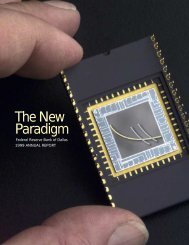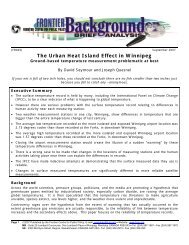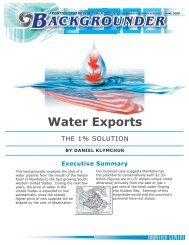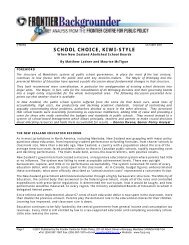The New Paradigm - Federal Reserve Bank of Dallas
You also want an ePaper? Increase the reach of your titles
YUMPU automatically turns print PDFs into web optimized ePapers that Google loves.
5<br />
Exhibit 2<br />
Technology Spillovers:<br />
Increasing Returns and<br />
Decreasing Costs<br />
Even when individual industries face decreasing returns to scale, the economy as a whole<br />
may enjoy increasing returns when technology spillovers from one industry benefit others.<br />
Technology spillovers are especially abundant with mother lode inventions, whose applications<br />
spread far and wide. Innovation in one company—though intended solely for internal<br />
benefit—can spark innovation in others, triggering a powerful, economy-wide cascading effect<br />
not unlike alchemy. Revolutionary technologies can take decades to spawn all their spillovers,<br />
during which, for all practical purposes, aggregate returns to scale increase.<br />
■ Texas Instruments was trying to reduce<br />
the size <strong>of</strong> electronic circuitry when engineer<br />
Jack Kilby developed the integrated<br />
circuit in 1958. <strong>The</strong> benefits <strong>of</strong> that innovation<br />
far exceeded what TI could internalize,<br />
opening a whole new science in which<br />
electronic circuitry would shrink to sizes<br />
once thought unachievable.<br />
■ Intel was pursuing circuitry small<br />
enough for a pocket calculator when Ted<br />
H<strong>of</strong>f developed the silicon-etching process<br />
that ultimately led to the microprocessor.<br />
A 1971 ad in Electronic <strong>New</strong>s heralded the<br />
“computer on a chip” and signaled the start<br />
<strong>of</strong> the digital age.<br />
■ In seeking<br />
to make<br />
microprocessors<br />
ever<br />
smaller, IBM developed<br />
the scanning<br />
tunneling microscope. <strong>The</strong> benefits <strong>of</strong><br />
that research, however, went far beyond<br />
what was envisioned. <strong>The</strong> microscope<br />
enabled an entirely new industry—nanotechnology—that<br />
promises to deliver molecularly<br />
engineered materials that will<br />
reshape our world.<br />
Economist Joseph Schumpeter clearly<br />
understood the economics <strong>of</strong> spillovers:<br />
“Most <strong>of</strong> us seem here to commit a mistake<br />
in handling the concept <strong>of</strong> decreasing<br />
returns. In its proper sense it applies only<br />
to given production functions and generally<br />
stationary conditions.“<br />
—Business Cycles, Vol. 2<br />
“Whenever…a given quantity <strong>of</strong> output<br />
costs less to produce than…before, we<br />
may be sure…that there has been innovation<br />
somewhere. It need not necessarily<br />
have occurred in the industry under observation,<br />
which may be only applying, or<br />
benefitting from, an innovation that has<br />
occurred in another.”<br />
—Business Cycles, Vol. 1<br />
“We are just now in the down grade <strong>of</strong> a<br />
wave <strong>of</strong> enterprise that created the electrical<br />
power plant, the electrical industry, the<br />
electrified farm and the motorcar….<strong>The</strong><br />
mere utilization <strong>of</strong> the achievement <strong>of</strong> the<br />
age <strong>of</strong> electricity…would suffice to provide<br />
investment opportunities for quite a time<br />
to come.”<br />
—Capitalism, Socialism, and Democracy<br />
italism. A novel idea and a little money can spark a billiondollar<br />
business almost overnight. Yesterday’s economy was<br />
dominated by establishment capitalism, with high barriers<br />
to entry that disadvantaged newcomers and new products.<br />
Economic change occurred at a slower pace.<br />
In the <strong>New</strong> Economy, knowledge is more important to<br />
economic success than money or machinery. Modern tools<br />
facilitate the application <strong>of</strong> brainpower, not muscle or<br />
machine power, opening all sectors <strong>of</strong> the economy to productivity<br />
gains. <strong>The</strong> Industrial Age ran on physical plant<br />
and equipment. Rapid productivity growth was the<br />
province <strong>of</strong> manufacturing, a shrinking segment <strong>of</strong> the<br />
economy for four decades.<br />
Scarcity, the first assumption <strong>of</strong> the old economy, isn’t<br />
the dominant feature <strong>of</strong> the <strong>New</strong> Economy. Many <strong>of</strong><br />
today’s markets are awash with goods and services. Sellers<br />
compete aggressively for buyers. <strong>The</strong>y discount. <strong>The</strong>y cut<br />
costs. <strong>The</strong>y expand markets through relentless promotion<br />
and advertising.<br />
Increasing returns to scale pervade the <strong>New</strong> Economy.<br />
More <strong>of</strong> today’s companies and industries thrive on quantity<br />
discounts—the higher the demand, the lower the price.<br />
Decreasing returns to scale dominated the old economy, so<br />
producing more goods and services pushed prices up. (See<br />
Exhibit 2.)<br />
<strong>Federal</strong> <strong>Reserve</strong> <strong>Bank</strong> <strong>of</strong> <strong>Dallas</strong> 1999 ANNUAL REPORT

















